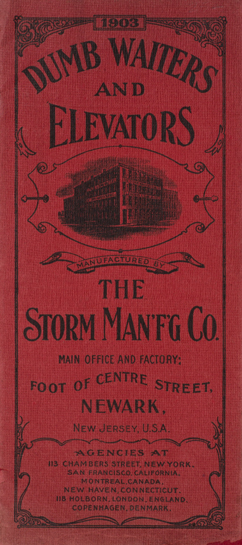10. "Dumb Waiters and Elevators." The Storm Manufacturing Company; Newark, NJ; 1903.
The technical advances necessary to allow for the development of the skyscraper were many, including skeleton construction, fireproofing for columns and beams, and improvements in foundations. But other than the skeleton itself, perhaps no other invention was more critical to the evolution of the skyscraper than this: the modern elevator.
Precursors to the elevator—the lift and the hoist—had long been in existence, but were slow, technically inefficient and considered generally unsafe. Elisha G. Otis was working in a bed-feather factory in upstate New York in 1851 when he struck upon the idea to design a safety brake which would engage automatically in the event of an accident. This effectively transformed the freight lift into a passenger lift. Two more innovations were needed before the modern elevator was complete: the electric motor (which was small, light and portable in comparison to the steam engine) and the invention of the friction-driven hoist in 1877 by mining engineer Friedrich Koepe. With this new combination of efficiency and safety, vertical travel was no longer an impediment to tall building construction.
"Tools of the Trade: 19th- and 20th-Century Architectural Trade Catalogs," Case 3, Ryerson & Burnham Libraries, August 4, 2015-October 12, 2015.
Link to R&B Archives Digital Collections record

